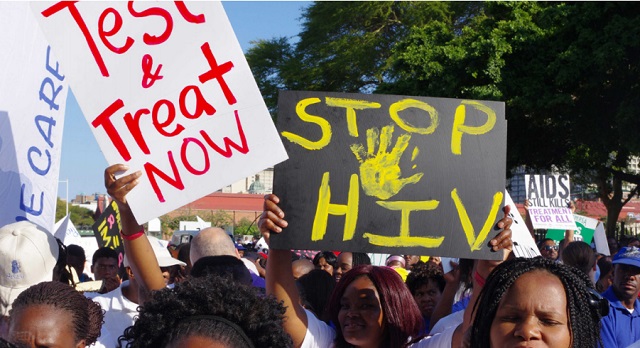
Discrimination and stigma still a challenge
Kampala, Uganda | PATRICIA AKANKWATSA | Every year on December 1, the world marks World AIDs Day. In Uganda, it has happened for close to the 37 years, but HIV remains of one the country’sheaviest burden among infectious diseases causing both death and long-term illness in varying proportions.
According to Uganda Population based HIV Impact Assessment Survey (UPHIA) 2016-2017, overall about 6.2% of all adults in Uganda are infected with HIV, the virus that cause the Acquired Immune Deficiency Syndrome(AIDS). The infection rate is higher among women at 7.6% for women while it is 4.7% for men.
Currently, there are 1.3 million people living with HIV and of these about 1.2 million are accessing Anti-Retroviral Therapy (ART). Meanwhile AIDS related deaths have reduced from 45,000 in 2011 to 28,000 in 2018.
Despite the great success of enrolment of many People Living with HIV (PLHIV) on treatment, stigma and discrimination remains a structural barrier to HIV prevention efforts.
Stigma happens when disgrace and shame become associated with an attribute, such as being HIV positive. It results in the person with the attribute being discredited or socially renounced. When stigmatised beliefs are widely held in a community, hostility and discrimination towards stigmatised people becomes common.
Nicolas Niwagaba the Executive Director of Uganda Network of Young People living with HIV/AIDs (UNYPA) says that internalised stigma happens when people living with HIV endorse negative attitudes and misconceptions associated with HIV from communities and accept them as applicable to who they are.
“A stigmatised person can start to believe these views as well and develop a self-depreciating internal representation of them. This is known as internalised stigma. It can lead to diminished mental health and emotional distress,” Niwagaba says. He adds that both general and internalised HIV-related stigma can compromise a person’s ability to seek and stay on treatment. And it can prevent people from taking steps to prevent infection.
He also says that stigma stops people from getting tested, stops them from discussing their test results with intimate partners when they do test, and then staying on their treatment.
Elizabeth Ruth Namutebi a young person who was born with HIV and founder of the Daria Kayitesi Safe Place; an NGO that advocates for young people living with HIV, agrees that internalised stigma is really a big challenge in the fight against HIV.
“There is a time I spent one year without taking medication. I felt ashamed. I didn’t want anyone to ask why I was taking medication every day,” Namutebi says.
“I was addicted to sleeping pills. I felt less beautiful, unwanted and lived in fear.I even overdosed one day. I just wanted my mind to shut down,” she adds.
“Unless stigma is addressed, the aim of ending the AIDS epidemic by 2030, one of the United Nations’ Sustainable Development Goals is unlikely to become a reality,” Niwagaba says.
According to a report by the National Forum of People Living with HIV/AIDS Networks in Uganda (NAFOPHANU) second national index study 2019, External forms of HIV stigma reduced much more than the internal forms that have reduced from 45% in 2013 to 1.3% in 2019.Whereas, internalised stigma reduced from 50% to 24%.
Internal Stigma is especially high among the males compared to the females which explain the high AIDS related deaths among men compared to the females.
Within the Key Population category, non-HIV related stigma and discrimination was almost six times more than the HIV related stigma compared to the general population yet their HIV prevalence is almost six times the national average in some instances.
The first National Stigma Index Report was launched in 2013; both reports indicate that internal stigma (individual feelings that often lead to negative actions) is higher than the external stigmathat manifests through community and family structures, workplaces and institutions.
Owing to the impact of HIV stigma and discrimination, Uganda joined other countries and organisations to progressively gather data, monitor and document the magnitude, forms and trends in HIV stigma to inform changes in HIV related laws, policies and programs to improve the lives of PLHIV. Organisations involved include the Global Network of People living with HIV (GNP)+, International Community of Women living with HIV (ICW), International Planned Parenthood Federation (IPPF) and the Joint United Nations Programme on AIDS (UNAIDS).
Curbing discrimination and stigma
The Minister for the Presidency, Esther Mbayo, says that if Uganda is to end AIDS by 2030, it requires the efforts of all of Ugandans to fight stigma and discrimination. Government officials, religious leaders, private sector actors, cultural leaders, artists, media practitioners, teachers, parents and people living with HIV all have a role to play
“Persons living with HIV should challenge or educate someone who is stigmatising and/or discriminating them as well as seek knowledge about organisations that he/she can go to for help if he/she experiences stigma or discrimination”, She says.
Niwagaba says that other organisations like UNYPA should come up and help in educating and empowering young people living with HIV about how they can live positively.
“We should strengthen programmes that build self-esteem, confidence of persons living with HIV in overcoming stigma and discrimination,” Niwagaba says.
“For example UNYPA implements the annual Y+ beauty pageant a campaign which aims at addressing stigma and discrimination and celebrating the inner beauty and goodness of young people living with HIV,” he adds.
He also notes that far away from the psychological support emphasised at most health facilities, there is urgent need to strengthen integration of mental health services into HIV/AIDs management.
“Majority of people living with HIV in Uganda suffer from depression, anxiety, yet their mental health needs remain unmet,” he adds.
****
 The Independent Uganda: You get the Truth we Pay the Price
The Independent Uganda: You get the Truth we Pay the Price


